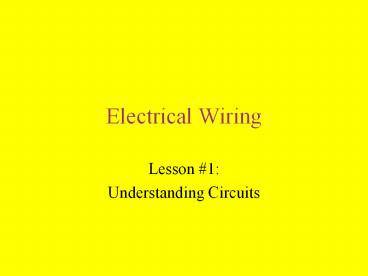Electrical Wiring - PowerPoint PPT Presentation
1 / 12
Title:
Electrical Wiring
Description:
Electrical Wiring Lesson #1: Understanding Circuits What is a circuit? Two or more conductors (wires) through which a current flows from a source to one or more outlets. – PowerPoint PPT presentation
Number of Views:4553
Avg rating:3.0/5.0
Title: Electrical Wiring
1
Electrical Wiring
- Lesson 1
- Understanding Circuits
2
What is a circuit?
- Two or more conductors (wires) through which a
current flows from a source to one or more
outlets. - The source is where the electrical current
originates within the house. Usually the breaker
box or breaker panel. - A conductor is any type material used to carry
electrical current. May also be called a wire.
3
- A cable is when two or more insulated wires are
bound together. - An outlet is any device that allows for the
escape of electricity. This may be a receptacle
or light fixture, etc.
4
Types of Circuits
- Branch Circuits
- A circuit that runs from a breaker to one or more
outlets. - Most circuits installed in homes are branch
circuits.
- Feeder Circuits
- A circuit between the breaker box and a
sub-panel.
5
Electrical Load
- Electrical Load is the total amount of electrical
current required. - Different types of circuits are needed to carry
the load in each room. - Wiring in each circuit is protected by an
overcurrent device, either a fuse or breaker. - If a circuit becomes overloaded, or a short
circuit develops, the breaker will open to stop
the current flow.
6
- By providing several branch circuits within a
house, it keeps costs down and allows for safe
operation. - The load carrying capacity of a wire is measured
in amperes and stated as ampacity. - If the ampacity is exceeded, the wire will burn
and melt. - Larger wire has a higher ampacity.
- Items that have higher electrical needs will
require larger wire with a higher ampacity.
7
AWG (American Wire Gage) Ratings
- All wire is given an AWG rating to describe its
diameter. - The smaller the number is, the larger the wire.
- No. 8 wire is larger than No. 10 but smaller than
No. 6.
8
3 Types of Branch Circuits
- General Purpose
- Small Appliance
- Individual Equipment
9
What is a General Purpose Circuit?
- Makes up the largest part of the wiring system
for a home. - Includes all lighting outlets and most
receptacles. - Sometimes called lighting circuits.
- They do supply lighting but many other items are
connected to them such as vacuum cleaners,
radios, televisions, etc.
10
- The Code requires at least 1 general purpose
circuit for every 500 square feet of floor space. - Either No. 12 or No. 14 wire may be used.
- If No. 12 wire is used, a 15 or 20 amp breaker
may be used. - If No. 14 wire is used, only a 15 amp breaker may
be used.
11
What is a Small Appliance Circuit?
- Circuits in the kitchen area to supply power to
mixers, toasters, blenders, and other small
appliances. - Code requires at least 2- 20 ampere small
appliance circuits in a home to supply power to
countertop receptacles. - Wire must be at least No.12 and protected by a 20
ampere breaker. - No lights are included on a small appliance
circuit, only receptacles.
12
Individual Branch Circuits
- A circuit that is wired directly from the breaker
panel to only one appliance or piece of
equipment. - It is used for items that require larger loads.
- Often called a dedicated circuit.
- Examples are Range, central heat, A/C, water
heater, garbage disposal, dishwasher.






























